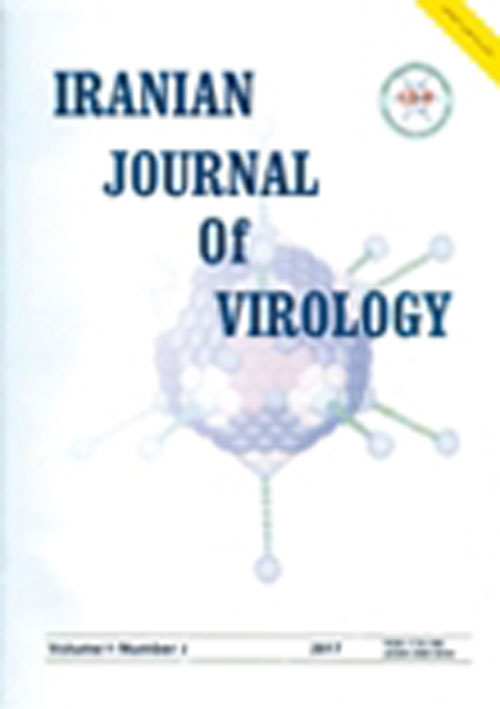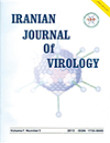فهرست مطالب

Iranian Journal of Virology
Volume:11 Issue: 3, 2017
- تاریخ انتشار: 1396/05/20
- تعداد عناوین: 6
-
-
Pages 1-6Background and AimsTGF-β is an effective cytokine in the viral replication cycle, which is also highly relevant to the pathogenesis of some viral infections. TGF-β induction by viral proteins is one of the ways to escape the virus from the immune system by inhibiting interferon signaling and other immune system factors. In recent years, the role of TGF-β and its inhibitory signaling has been confirmed in clinical trials. In this study, using SB431542, a TGF-β type I activin receptor like kinase inhibitor, the effect of TGF-β reduction on IFN expression and antiviral activity in PBMCs of patients with chronic hepatitis C was investigated.Materials and MethodsPBMCs from 10 patients with chronic hepatitis and 5 healthy individuals were isolated with Ficoll solution and cultured in the presence of different concentrations of sb431542. RNA was extracted at different time points of culture, with Qiazol lysis reagent and cDNA was synthesized with commercial kits. The relative expression levels of TGF-β, IFN-α and HCV Core mRNA were determined using with REAL TIME PCR. The expression level of TGF-β protein was also measured in supernatant of cultured cells by ELISA method.ResultsThe inhibitory effect of different concentrations of SB431542 at various time point showed that it peaks 48h after treatment and the maximum increase of IFN-α expression and significant antiviral effects reached 72 h after treatment.ConclusionsThe effects of TGF-β on IFNs may be correlated with inverse ratio depending on the level and duration of expression, which indicates the regulatory role of these proteins in the immune system against the viruses. TGF inhibitory drugs can augment immune system against the viruses.Keywords: TGF-?, IFN-?, SB431542
-
Pages 7-12Background and AimsInfluenza vaccine production process is time-consuming with little-to-no cross-protection which requires annual adjustment. The construction of a universal vaccine to deal with the pandemics and epidemics which occasionally threat human population is the aim of many researches worldwide. Today, influenza vaccines are mostly against two major antigenic proteins, hemagglutinin and neuraminidase. As compared to high variable globular head, the hemagglutinin stalk domain is more conserved among different subtypes of influenza A viruses which could be a good candidate to develop a cross-protective vaccine.Materials and MethodsIn this study, recombinant HA2 protein comprising fusion peptide was expressed in E.coli, purified using Ni-TED columns, refolded and desalted by dialysis. BALB/c mice in different groups were immunized with HA2 alone or supplemented with Alum or Alum/CPG. Vaccinated mice sera were examined for anti-HA2 specific IgG responses. Finally, mice were challenged with one LD90 of mouse-adapted A/PR8 virus.ResultsThe results showed that HA2 recombinant protein could provoke immunogenicity in BALA/c mice and this immune response could be elevated with Alum and Alum/CpG. Despite promising immune responses, there was insignificant protection of HA2-immunized mice when challenged with the mouse-adapted strain A/PR8.ConclusionsTherefore, HA2 protein alongside with other influenza virus conserved proteins should be studied to achieve a suitable vaccine formulation for broad spectrum cross-reactive immune responses.Keywords: influenza virus, Hemagglutinin, CPG, Alum
-
Pages 13-18Background and AimsHuman T-lymphotropic virus type 1 (HTLV-1) is a member of retroviridae family that causes ATL and HAM/TSP. Many inflammatory diseases are associated with this virus, such as Sjögren's syndrome, Hashimoto's thyroiditis, Uveitis and also Atherosclerosis. HTLV-1 performs in long latency period and can activate the immune responses in coronary vessels. Activated immune system produces inflammatory factors such as TNF-α cytokine that can increase Matrix Metalloproteinases as a main factor in patients with coronary artery diseases (CAD). We aimed to determine the relation between this virus infection and MMP-3 expression in Atherosclerosis patients.Materials and Methods44 patients (13 individuals CAD+ HTLV-1+, 8 individuals CAD- HTLV-1+, 13 individuals CAD+ HTLV-1- and 10 individuals CAD- HTLV-1-) were selected and MMP-3 gene expression was measured by Real-time polymerase chain reaction.ResultsThere was no significant correlation between MMP-3 gene expression and HTLV-1 expression level in HTLV-1-positive cardiac and Atherosclerosis patients.ConclusionsAlthough the main risk factor in Atherosclerosis patients is MMP-3, despite our expectation, no significant correlation was observed in our statistical analysis within four examined groups (p≥0.05). This evaluation showed higher MMP-3gene expression but not significant in CAD+ HTLV-1+ group compared to CAD+ HTLV-1- group. The larger sample sizes may help to improve the outcome to reach a significant level.Keywords: HTLV-1, MMP-3, TNF-?, Atherosclerosis, Real-time PCR
-
Pages 19-26Background and AimsIron oxide nanoparticles are among the most effective tools which can replace current medical techniques for diagnosis and treatment of various diseases. Hepatitis C infection is one of the main health problems in the world, affecting around 3% of the world's population. This infection can develop into liver cirrhosis and liver cancer over the time in 80% of patients.
In this study, the effects of PEG interferon loaded iron oxide nanoparticles on hepatitis C virus infection compared with unloaded nanoparticles was studied in vitro.Materials and MethodsFirst, Huh7.5 cells were cultured to replicate the hepatitis C virus. After loading the peg interferon alpha on iron oxide nanoparticles, their effects on the replication of hepatitis C virus was investigated by several methods.ResultsThe results of this study showed that iron oxide nanoparticles and peg interferon loaded iron oxide nanoparticles were able to reduce the load of hepatitis C virus in infected cell culture, but differences were not statistically significant.ConclusionsThese data indicated that hepatitis C viral load was decreased in infected cells after induction of PEG interferon loaded iron oxide nanoparticles, but it needs more research to clarify in animal models or even to examine with other types of bare and drug-loaded nanoparticles in a similar way to our study.Keywords: Hepatitis C Virus_Nanoparticles_Iron Oxide_Hepatitis C Virus Treatment_Peg Interferon -
Pages 27-32Background and AimsMultiple Sclerosis is a chronic and autoimmune disease, which causes inflammation and demyelination of the axons in CNS. Studies have indicated that Herpesviruses might be one of the potential environmental elements that can trigger the initiation of the inflammatory cascade in MS. The purpose of this study was to determine whether the genome of CMV and (or) EBV is present in PBMCs of the MS patients and healthy individuals and if so, consider the sequencing process for DNA-positive samples.Materials and MethodsBlood samples from 50 MS patients and healthy people were collected and extraction of DNA was done on PBMCs of the mentioned samples. PCR was used for conserved and variable regions of the genome to seek the presence of EBV and (or) CMV DNA in extraction products.ResultsNeither in PBMCs samples of the MS patients (n=50) nor in those of healthy individuals (n=50) could we find any evidence to prove the presence of the two mentioned viral DNAs in DNA extraction products of the PBMCs samples. Genotyping of mentioned viruses was consequently omitted from the study purposes.ConclusionsBased on the findings in this study, there seems to be no significant relation between CMV/EBV infection and the risk of MS development.Keywords: CMV, EBV, Multiple Sclerosis, PCR
-
Pages 33-40Influenza viruses continue to be a major health threat in human and bird populations. The improvements in formulation and production level of the current influenza vaccines are not sufficient to afford complete protection. The continuous antigenic drifts and emergence of endemic and zoonotic strains make influenza vaccine planning difficult. Concern about the emergence of new influenza pandemic provides subject for developing a universal influenza vaccine to be most effective in preventing influenza A either by targeting the HA or other viral proteins. The recombinant and synthetic antigens used in influenza vaccine research and development are generally less immunogenic and need to incorporate novel adjuvants with modified delivery carriers to develop broad-protective vaccines.Keywords: Influenza virus, vaccine, adjuvant, delivery system


